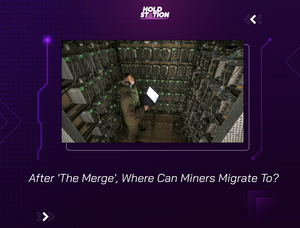
Once The Merge is complete and Ethereum completely switch to Proof-of-Stake, it will put an end to the ETH mining market as all transactions made on the ETH chain will be executed by validators. Therefore, if the transition to PoS is successful, Ethereum miners will become obsolete. With that scenario, what can miners do with their hardware after The Merge?
Convert to stake and become a validator for the Ethereum network
As mentioned above, ‘The Merge’ will help Ethereum become a PoS Blockchain, and operations on the network will be performed through the validator. The network will require staking of at least 32 ETH to be able to run a node. For each validated transaction, the validator will receive rewards in the form of block rewards, tips, and MEV (Miner Extractable Value).
To be able to stay with Ethereum, miners can completely convert their roles into validators with the amount of ETH that has been accumulated through the previous mining process and from the amount of capital recovered if the miner is liquidated. For miners who don't have enough 32 ETH or who don't want the responsibilities that come with running a validator node, staking pools and services can also provide alternative services in the future.
Switch to mining other PoW coins

Or suppose you do not want to liquidate the number of miners that they themselves have invested. In that case, the miners can completely continue to use them if they switch to another ecosystem that is still using Proof-of-Work mechanisms like ETC, DASH, ZEC, SC,... (BTC uses ASIC dedicated miners, which cannot be mined with GPU). However, mining alternative Proof-of-Work coins will not be economically sustainable for most Ethereum miners.
The total market capitalization of GPU-mineable coins excluding ETH is $4.1 billion, or about 2% of ETH's market cap. ETH also accounts for 97% of the total daily revenue of miners for GPU-minable coins (data from Messari, June 2022). And if GPU miners flood the alternative PoW coins, the mining difficulty of those coins will increase significantly, resulting in lower mining rewards. This will push the majority of miners out of being profited.

Meanwhile, with ETH ASIC miners, Ethereum Classic will be the only alternative because its hashing algorithm is compatible with that of ETH. At the same time, they cannot be used for other purposes and will completely “go underground” if ETC mining is not profitable. However, Ethereum Classic has also had certain growth ahead of The Merge in both TVL and transaction volume, but still focuses mainly on the only Dapp, Hebeswap.
It is because of the conflict of interest that miners have come up with hard fork ideas to create an ETHW network that continues to use PoW after The Merge. This was met with criticism from Vitalik Buterin, the creator of Ethereum. But with the backing of Justin Sun and the Poloniex exchange, as well as Chandler Guo, who participated in the hard fork that created Ethereum in 2016, vowed to take charge of this fork that makes it so popular more likely to happen.
Provides rendering capabilities for Web3

Web3's goal is to enable the internet to become an open, decentralized, and permissionless protocol. To really achieve this goal, Web3 needs to use a lot of infrastructure for applications that stream video, render 2D and 3D objects, and cloud servers. These services have in common that they can all operate on a distributed network of participants providing GPUs.
As such, miners can transfer their resources to a variety of Web3 protocols such as:
Render Network: A decentralized GPU marketplace that allows users to contribute GPU computing power to render and get rewarded accordingly.
Livepeer Network: Decentralized marketplace for live streaming applications that require video processing services.
Akash Network: A decentralized cloud computing marketplace that connects users looking for computing resources with readily available vendors.
Transforming excavators into centralized data centers

Huge mining organizations are gradually turning to the high-performance computing industry instead of switching to other token mining.
Hut 8 and HIVE Blockchain, two big names in the blockchain data mining industry, have made acquisitions of other data center businesses to position themselves in the long term following 'the Merge' transition.
The idea behind these data centers is to provide an alternative to cloud computing giants like Amazon Web Services.
Zero Knowledge Proof Application

Zero Knowledge Proofs (ZKP) allows for proving the transparency of assets without having to disclose it to other intermediaries. ZKP is the essential solution for improving the security and scaling of the blockchain. With ETH 2.0 focused on rollups, zk-rollups are becoming increasingly popular as Layer 2 scaling solutions, with projects like Polygon ZkEVM, Starknet, and zkSync on the rise.
The future ZKP also aims to use specialized miners (ASICs) to mine resources, but at the current stage of development, this technology still needs to use the processing speed of GPUs. As a result, miners can leverage existing GPU resources into ZKP as a temporary solution, while looking for a longer-term direction.
In short, a successful The Merge could be the end of Proof-of-Work mining. However, this is also a turning point for miners to start looking for new opportunities in Web3 and other areas.



